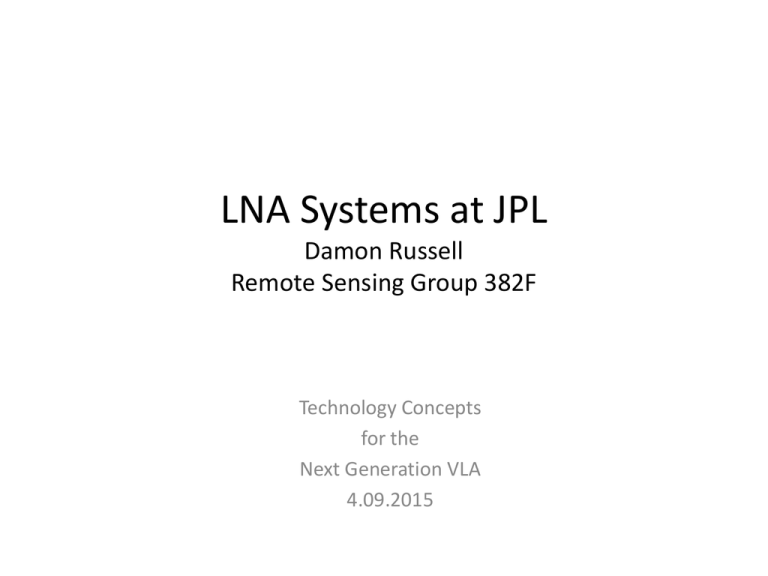LNA Systems at JPL
advertisement

LNA Systems at JPL Damon Russell Remote Sensing Group 382F Technology Concepts for the Next Generation VLA 4.09.2015 DSN LNAS DSN LNA Systems Overview JPL 238 TRX Measurements Ka Development Rx Cartridge Rx Testing at JPL Noise (K) • Cryogenic receivers at S, X, and Ka DSN communication bands • InP based LNAs with 3-9 K noise temperature • Receiver systems include OMTs, noise sources, and calibration loads, cooled by CTI-350 and Sumitomo 4K Cyro-coolers • Prototype systems fielded at DSS 13, a 34 m Beam Waveguide Antenna, Goldstone CA. 120 110 TRCP Old 100 TLCP Old 90 TRCP New 80 TLCP New 70 60 50 40 30 20 10 0 26 27 28 29 30 31 32 33 34 Frequency (GHz) 35 36 34 m Beam Waveguide Antenna DSS 13 37 38 Current DSN X and Ka Band Amplifiers • Discrete “chip and wire” designs based on “Cryo-3” InP devices • 3-4.5 K noise at 8.2 GHz, 9 K at 32 GHz • Increasingly challenging to tune, as best portions of Cryo-3 wafers have been DSN X-Band LNA SN 44 depleted. 40 X-Band LNA Module NOISE GAIN Noise (K), Gain (dB) 35 30 25 20 15 10 5 0 2 4 6 8 10 Frequency (GHz) 12 14 DSN Ka-Band LNA SN 66 Cryo-3 Wafer 40 GAIN NOISE Noise (K), Gain (dB) 35 30 25 20 15 10 5 0 24 *Photos and data courtesy of E. Long, JPL 26 28 30 32 34 Frequency (GHz) 36 38 40 Next Generation X Band Amplifiers • OMMIC D007IH 70 nm process • T50=4.4 K, 3-4 K with external matching network. • Gain = 37 dB • Unconditionally stable • Tape-out also includes 50, 80, 120, 200, 400, and 600 um discrete devices for characterization purposes X-Band MMIC 1.5 x 1 mm MMIC T50 and Tmin @ 15 K MMIC [S] Parameters *Cryogenic transistor models courtesy Prof. A. Akgiray, Ozyegin University X-Band LNA Module • 1.1 x 1.8 x .4 inch, SMA connectorized package • Integrated bias protection network, micro-D connector • T50=3.5 K • Gain = 37 dB • S11, S22 better than 15 dB Module T50 and Tmin @ 15 K *Mechanical drawings courtesy R. Higuera, JPL. Sublid Module [S] Parameters Ka-Band InP MMIC • Ka Band MMIC fabricated on NGST 35 nm InP process. • T50=7.2 K • Gain = 33 dB • S11, S22 better than 12 dB. • Unconditionally stable. MMIC T50 and Tmin @ 15 K *Assembly photo courtesy S. Montanez, JPL. MMIC [S] Parameters SIGE IF LNAS FOR TERAHERTZ MIXER ARRAYS REQUIREMENTS • Small size # of pixels • Low power consumption burden on cryogenics, # of pixels • Minimum number of connectors ease of packaging, service • Low input return loss minimize effect of standing waves between mixer and LNA System Concept SiGe MMIC, 570 x 1500 µm 4 x 4 Array Example SiGe IF LNA Developed for CHAI/GUSSTO • 2-8 GHz • 8 K noise with 10 mW DC power • Integrated bias-tee in output line, no separate DC connector required. • Resistive feedback for low S11. • 13.7 x 5 x 22.5 mm package with GPPO connectors. LNA Performance at 5, 10, and 16 mW DC Power Tamb=15.8 K Tamb=15.8 K 24 22 40 Bias 1 Bias 2 Bias 3 30 16 14 Gain (dB) Noise (K) 20 18 12 10 8 6 4 25 20 15 10 5 2 0 0 Bias 1 Bias 2 Bias 3 35 2 4 6 8 10 12 Frequency (GHz) *Assembly courtesy S. Montanez & M. Soria, JPL. 14 16 18 0 0 2 4 6 8 10 12 Frequency (GHz) 14 16 18











